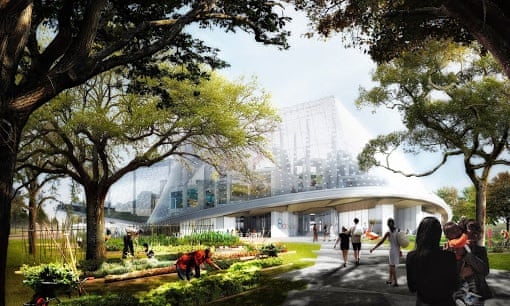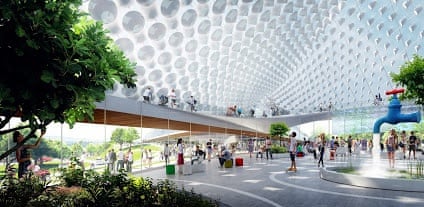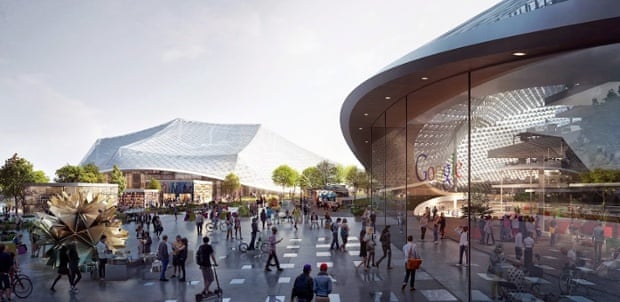완벽한 전원적 유토피아를 구현하는 구글 신사옥 Google's new headquarters: an upgradable, futuristic greenhouse(VIDEO)
Nestling like misshapen dewdrops ... a bike track alongside the new headquarters. Photograph: Google
edited by kcontents
케이콘텐츠
덴마크의 세계적 건축가 비야케 인겔스와 토마스 헤더 윅이 설계한 캘리포니아 새 구글 본사. 마치 꿈속의 전원적이고 와이파이 환경을 갖춘 유리 돔 건물이다. 구글에 따르면 유리돔으로 만들어진 본사 건물은 신록의 농장과 자전거 도로 및 요가 클래스 분수가 솟구치고 그 옆에는 시냇물이 흐르고 야생화가 가득한 초원 그리고 습지 등이 자리한다. 와이파이까지 갖춘 완벽한 전원적 유토피아인 것이다. 황기철 콘페이퍼 에디터 |
Oliver Wainwright @ollywainwright The future of work, according to Google, will take place in woodland glades and wildflower meadows, next to trickling streams and verdant allotments, among bike paths and yoga classes and gushing fountains, with fresh produce on tap. It will be a pastoral utopia-with-WiFi, all safely swept beneath a series of gigantic glass tents. Silicon Valley’s mother of all tech companies has today unveiled plans for its gargantuan new headquarters in Mountain View, California, designed by global star architects Bjarke Ingels and Thomas Heatherwick. And it looks like a futuristic Center Parcs. “What is the best possible environment we can make to invent, engineer and make ideas happen and go out into the world?” asks Thomas Heatherwick in the promotional video, which was launched on Friday without fanfare on Google’s own blog. “When you visit the Google campus, there’s lots of trees,” he adds, “but there’s this constant undermining by the road system and the infrastructure required for all those cars.” Their strategy, says Ingels, is to “transform the sea of parking into a natural landscape, where you’ll find an abundance of green both outside and inside.” The proposal takes the form of a series of vast greenhouses, nestling like misshapen dew drops in the suburban landscape of Mountain View, beneath which a flexible series of structures can accommodate all manner of interdisciplinary, cross-pollinating, hot-desking tasks. And lots of swoopy bike paths. “The idea here is simple,” says David Radcliffe, Google’s vice-president of real estate. “Instead of constructing immoveable concrete buildings, we’ll create lightweight block-like structures which can be moved around easily as we invest in new product areas.”
Plug and play, click together: how the new headquarters might look. Photograph: Google It’s a kind of plug-and-play, click-together city, highly reminiscent of the dreamy projects of experimental 1960s group Archigram, whose Plug-in City envisaged a world of modular pods stacked up in a flexible framework. The architects’ images show a similar vision, of boxy blocks piled up in a frame, with cascading terraces and room to expand, looking like it will have the capacity to add rooms here and there, like stack of construction site Portakabins. Or Lincoln Logs, as Radcliffe likes to put it. In Ingels’ words, the architecture will be “giant pieces of furniture that can be connected in different ways”. At the core of the plan is the dream of ultimate flexibility, a future-proofing strategy based on the idea that we don’t know what work will be like in 10 or 20 years’ time. It’s treating architecture as software, imagining a building that can be continually updated just like the latest apps. And if the whole place is run by the devices of Google’s “smart home” arm, Nest, then that may literally be the case. Although my guess is that work will still involve sitting at a desk locked to a computer for most of the day. In fact the video shows tiny orange model-people sitting on precipitous white ledges, as if driven to distraction by their flexible workspace and contemplating jumping off. Then, thankfully, the nature metaphor returns to reassure us. “In nature, things aren’t over-prescribed,” says Ingels, as the camera pans across a rolling meadow. “If our work environments could have more of this flexibility and openness for interpretation, they would become more stimulating environments to work in.” Working among nature is at the core of the design, with images showing the office modules draped with vines and climbing plants, and Googlers working outside on laptops beneath trees. But it’s not going to be any old nature. Not like the trees in pots that have been so underwhelming in the promised “sky garden” of London’s Walkie Talkie. As Heatherwick puts it, sounding like some botanical alchemist, it’s about “how you can augment, or turn the dial up more on that nature.” And it’s a super-charged pastoral dream made possible year-round by the great glass tents.
Inside the Google dome. Photograph: Google The big roof ambition recalls Buckminster Fuller’s 1960 scheme to cover Manhattan with a geodesic dome, or Richard Rogers’ 1994 plan to swamp London’s Southbank Centre with an enormous undulating tent, and the whole sweep-it-under-one-big-roof idea has a decidedly retro air. More recently it has become the go-to choice of dictators, with such projects as Norman Foster’s big-top funhouse in Kazakhstan, the mother of all autocrats’ marquees. The Ingelswick tents, however, look set to trump all tents that have gone before, depicted as ethereal spiders’ webs poking above the trees. Heatherwick describes the strategy simply as “glass fabric draped over tentpoles” – but as he does so, he is filmed fondling a mysterious origami umbrella. These little umbrellas, it seems, will be strapped to the underside of the tents to act as a responsive shading device, opening and closing with the weather like a sky-sized field of sunflowers. It’s a charming idea, and Heatherwick has a track record of making exquisite and ingenious things at the smaller scale, but countless are the buildings whose experimental responsive sun-shading systems have gone wrong. From Jean Nouvel’s mechanical lenses at the Institut du Monde Arabe in Paris, which ended up singeing holes in the carpet, to the mechanical blinds in Foster’s London City Hall and Sanaa’s Novartis campus, both of which malfunctioned soon after opening and have plagued their occupants ever since. Still, if anyone can make responsive tech work, you would hope Google can.
The other key tenet of the whole plan is to make the campus more than just for Google employees alone. The company has come under fire from local residents for generating vast amounts of traffic, jacking up property prices and giving little back in return. There’s no sales tax on Google’s search or advertising businesses and no tax on the free meals that Google gives to employees either. “They aren’t the cash cow that everyone thinks they are,” city council member Mike Kasperzakhas has said. “But I don’t want them to leave.” They are, after all, the city’s biggest employer. Mindful of being seen to be a good neighbour, Radcliffe insists that the buildings will be “very open and accessible, not just for Googlers, but for anyone who lives in the area to come by.” Heatherwick suggests it will be a place where you “would go for a walk with great pleasure” and hang out at the weekend. Such a supposedly transparent, democratic set-up is a bold ambition, and it stands in striking contrast to Apple’s plan for a hermetically sealed doughnut, designed by Norman Foster, which shares all of the biophilic ambition of Google – as a gleaming UFO set in a 176-acre garden – but will welcome few outsiders into its mothership. “It can’t be a fortress that shuts away nature and the neighbours,” says Ingels, promising that the new Googleplex will have “the diversity and liveliness you find in an urban neighbourhood”. A Silicon Valley Truman Show, entirely calibrated and controlled by Google’s optimisation analytics. What could possibly go wrong? |
edited by kcontents
"from past to future"
데일리건설뉴스 construction news
콘페이퍼 conpaper
.












